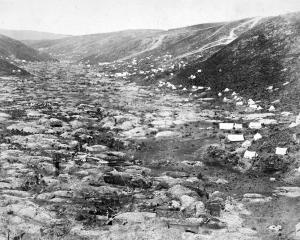
Controversy has swirled around Toumai, the name given to the nearly-complete skull, since it was found in the Chadian desert in 2001.
Toumai's big defender is French palaeontologist Michel Brunet, a professor at the College de France, who says Toumai walked the Earth shortly after chimpanzees and hominids diverged from a common ancestral primate.
Prof Brunet has been roundly attacked in other quarters.
Critics are incensed that he has given a hominid honorific (Sahelanthropus tchadensis) to a creature whose cranium, in their view, was too squashed to be that of a precursor of Homo sapiens.
They calculate that Toumai's height was no more than 120cm - or that of an adult chimpanzee.
Prof Brunet appeared to have scored a knockout blow in February this year, when radiological measurements estimated that the soil where Toumai was found was between 6.8 million and 7.2 million years old.
The study appeared in a top-line US journal, the Proceedings of the National Academy of Sciences (PNAS).
But the man who discovered Toumai, Alain Beauvilain, of the University of Paris at Nanterre, has now publicly challenged this estimate.
Dr Beauvilain declined to take part in the hominid versus chimp debate, but said he questioned the dating methods and the way the result had been presented to the public.
"It's time to set the record straight," he said.
In general, radio-dating of the sediment in which a fossil is found is considered to be a good guide to when the creature died, its remains eventually becoming covered by soil or other debris.
But Dr Beauvilain, a Chadian fossil authority of long standing, says that, contrary to Prof Brunet's assertions that the fossil had been "unearthed", the cranium was found loose on the sand.
A thick blue ferruginous, or iron-based, mineral encrusted the skull, which showed clear signs of weathering from desert conditions, Dr Beauvilain says in a commentary in the South African Journal of Science.
Dr Beauvilain says it is clear that the soil around the find, and possibly the find itself, had been shifted by wind or erosion, a phenomenon that can happen swiftly and frequently in the desert.
So carbon-dating the soil and attributing that to the skull was a perilous exercise, he says.
"How many times was it exposed and reburied by shifting sands before being picked up?" he asks in the commentary.
Dr Beauvilain also takes issue with the soil samples used for the PNAS study and analysed by experts from France's National Centre for Scientific Research (CNRS).
He says these samples were taken selectively and did not give a full picture of the depth and range of topography in which the find was made.
He describes some of the collection choices as "astonishing".
On the same grounds, Dr Beauvilain attacks Prof Brunet's dating of an ancient Chadian jawbone, dubbed Abel and estimated to be between three million and 3.5 million years old.
"Abel," too was picked up on the surface in 1995, and was not embedded in the soil, he says, showing photos of both finds on their day of discovery.
The debate is important because of its implications for anthropology.
Toumai - the name means "hope of life" in the local Goran language - was found 2500km west of the Great Rift Valley, until now considered the cradle of humanity.
So if the skull's dating is right, it implies the early hominids ranged far wider from east Africa, and far earlier, than previously thought.
The discovery also implies hominids evolved quickly from apes after they split from a common primate ancestry.
Hominids are considered the forerunners of anatomically modern humans, who appeared on the scene about 200,000 years ago.
Still unclear, though, is the exact line of genealogy from these small, rather ape-like creatures to the rise of the powerfully brained Homo sapiens.












